“The life purpose of the true social entrepreneurs is to change the world.” With these iconic words Bill Drayton, founder of Ashoka, defined the leading traits of social entrepreneurs. Since its foundation, Ashoka’s mission has been to sustain thousands of social entrepreneurs in their efforts to produce social impact and spread the mentality of changemaking.
However, and particularly in the last years, Ashoka has not been the only actor moved by the urgency to make an impact. Several international organizations have been echoing Ashoka’s claims, addressing deep-seated societal problems and suggesting avenues to solve them.
A paradigmatic case is the exhaustive and ambitious list of action points developed by the UN to change the pace of social progress and inclusion: the 17 Sustainable Development Goals (SDG). SDG’s are of primary importance, helping to concretely define the most urgent issues the world is facing as a whole, analyzing the relative problems and bottlenecks, and promoting clearly identified avenues to solve them.
With the most urgent issues at hand, it becomes pivotal for Ashoka and its network of social entrepreneurs to understand how far they have gone in tackling them, and which paths to walk to achieve a more pervasive social impact and scale.
In this article we offer a perspective on this point with the analysis of the “Alignment Issue-Mission” (AIM) index that we created to measure the alignment between the most urgent issues faced by a country and the mission pursued by the Ashoka fellows operating in it. We computed the AIM index for all project fellows undertaken in each country and analyzed how its distribution changed over time between 2014 and 2017. Additionally, we also separated fellows’ projects in groups according to their technology familiarization, profit-seeking intentions, and community-building purposes, and checked the difference in the AIM index among these groups.
To build the AIM index we moved our first step from the country level. For each country we measured the importance of fundamental issues as captured by official documents produced by the World Economic Forum (from which we retrieved data on education and labor), Global Entrepreneur Monitor (for governmental support to society and economy), Yale Center for Environmental Law & Policy (for environmental impact), and the United Nations Development (for capability to support economically individual growth1). From these documents we obtained values indicating how much Education, Labor, Government support, Environmental impact, and Economic support to individual growth were deemed as crucial issues for each country in 2014 and how they change their ranking for 2017. We then dichotomized these values (urgent/not urgent) and produced, for each country, an array indicating with “1” the most pressing issues and with “0” those that were not considered as vital.
Second, we “scraped” the information relative to the almost 3,000 fellows displayed on the Ashoka website in 2014. The polished data gave us information on the mission statement of 2,907 projects undertaken by the fellows, thus allowing us to understand the strategic direction pursued. This information was then codified into binary variables, expressing the existence -- or lack -- of a specific scope of action in the mission as captured by the presence -- or absence -- of specific keywords. The following table presents the mapping between the issues we have identified at the country level and the chosen keywords in the mission statement of each project.

Again, an array was created to identify for each project what fields of action were indicated in the project’s mission, and which were excluded instead.
Comparing the array built for countries and that built for fellows’ projects we could determine whether the presence or lack of a specific urgent issue in the country coincided with the presence or lack in the mission of the related word, and thus to what extent a fellow’s project is aligned with the related country’s most urgent issues.
The AIM index expresses this alignment as the percentage of issues for which the fellow and the country are aligned (i.e., they both have included the issue among those deemed actionable, or both have not done so) over the issues for which country-level data were present.
For example, if for a specific country we could find data within the mentioned reports only on four issues (for example because we found no information on education), an AIM index of 25 percent means that the project’s mission is aligned only for one issue out of four, either because it refers to an issue deemed as urgent or because it does not refer to an issue deemed as not urgent. For the other three issues, the mission statement points in directions different from those indicated by the documents mentioned above.
In the following we will analyze the distribution of the AIM index in different times and/or for different groups of fellows.
We start from the distribution of the AIM index over time comparing years 2014 and 2017. Most fellows’ projects fall into the 40-60 percent interval, meaning that the large majority of their missions address some of the most urgent issues in the country. This match is particularly important in light of a “call for concreteness” that changemakers need to address when facing the severe problems affecting our society.
This situation is marked by a certain level of stability over time: the distribution of the AIM index (as shown in the graph below) is very similar between 2014 and 2017, and so are the averages in the two periods (50 percent for 2014 and 48.7 percent for 2017). With a notable change: while the two peaks in 40 percent and 60 percent cover almost the same percentage in 2017 (around 26 percent each), the peak for 40 percent diminishes considerably, and that for 60 percent increases slightly over the three subsequent years. While this change is likely compensated in the tails (hence the similar average) if we focus on this portion of the distribution, Ashoka fellows seem able to anticipate changes in the relative urgency of different issues for their country, sensing since the beginning what will really matter for their context.
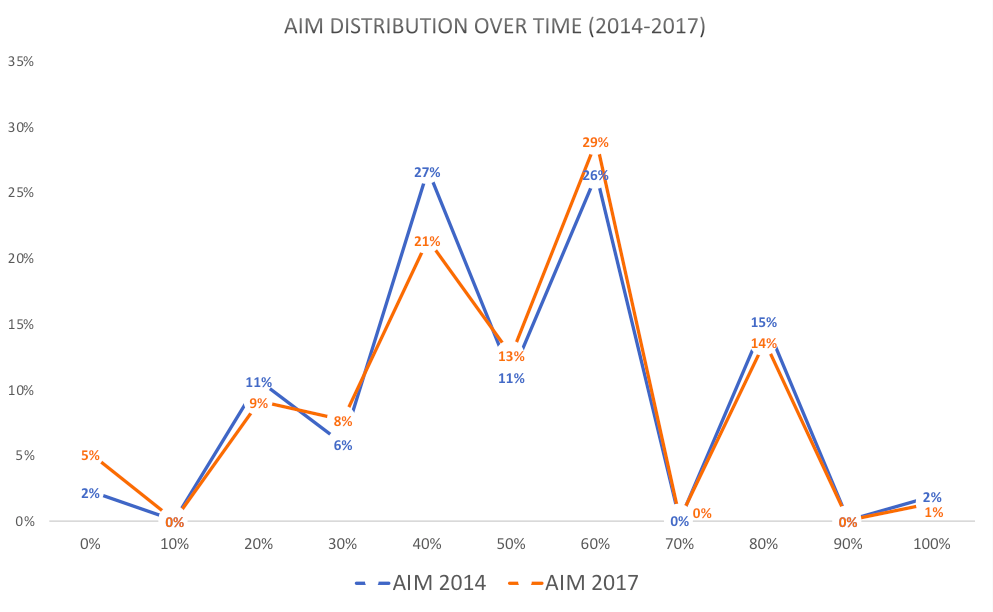
We now investigate in the two graphs below whether the AIM index differs among those projects that directly refer to communities in their mission and those that do not, to assess the effect of anchoring the project to a specific reference group.2
As the distributions clearly show, projects that are not explicitly focused on communities are less aligned to the country issues in both years. Indeed, the average AIM for the projects not referring to communities is 47.6 percent in 2014 and 44 percent in 2017, while for those referring to communities it remains always around 50.3 percent. Moreover, when computing the average of the distributions, the gap between the projects that contain “community” in the mission and those that do not more than doubles from 2014 to 2017 (moving from about 2.7 percent to about 6.3 percent). Such results highlight how the engagement with the community is a crucial tool for fellows to be aware of -- and possibly anticipate -- the most important issues to be tackled in their countries. This observation must be seen in the light of the diminishing number of projects that over time refer explicitly to a community: from 2,218 to 2,175, a two percent decrease in three years. Despite remaining a large majority of the 2,907 projects, community-based projects are not growing in number and actually show a slight contraction, leaving room for Ashoka to act in order to promote this fundamental pillar of any changemaking process.
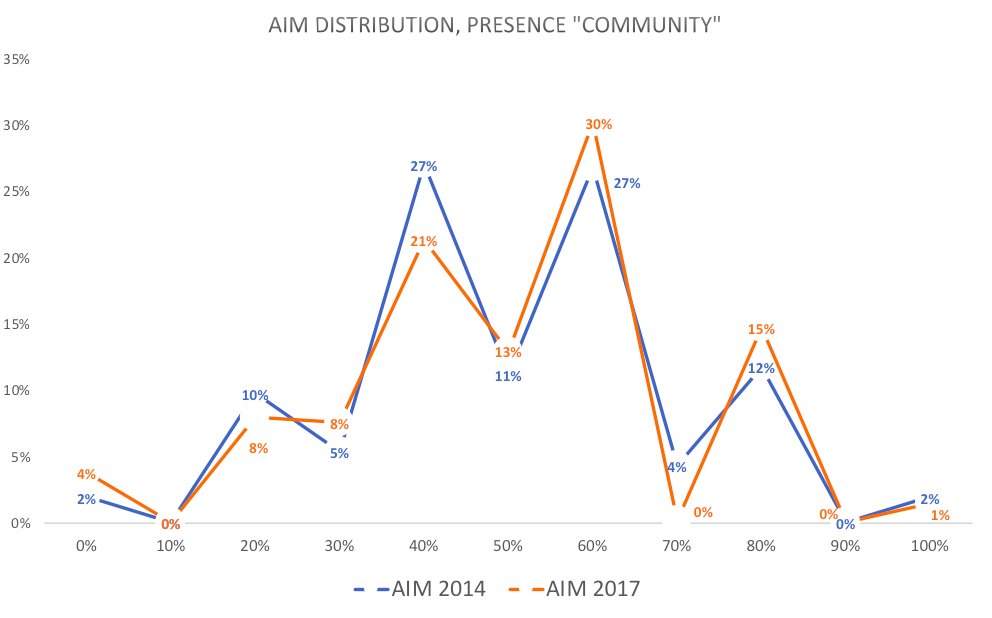
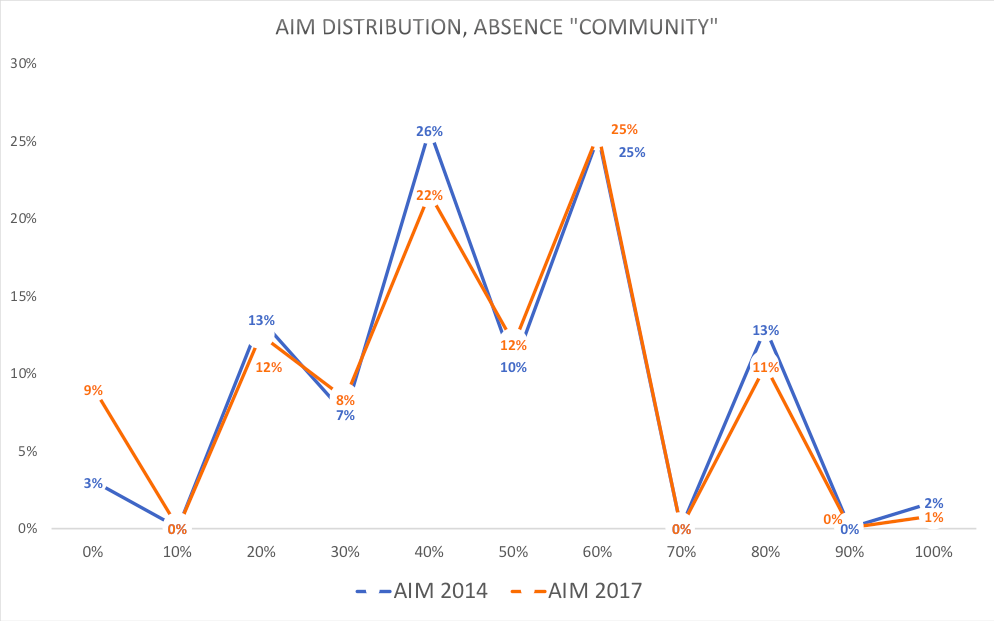
The two graphs provided below show the impact that including the term "profit" in the mission can have on the AIM index.3 In this case, the situation is the opposite of the one seen for the inclusion of “community.” The projects that explicitly talk about profit are not many (about 260 out of the 2,907), but present a lower alignment compared to those that do not pursue such logic: the first group has an average AIM always equal to 46.1 percent while the same average for the second group varies from 49.9 percent in 2014 to 48.3 percent in 2017.
This situation can be explained by the different actions that underlie an explicit profit-seeking logic: the fellow must “discipline” his/her choices in terms of resource allocation not only considering what is deemed important for the context he/she operates in, but also in terms of economic sustainability beyond donations and government grants, and towards the creation of viable business models. This likely implies more focus, and the need to find compromises between the different social objectives and the creation of economic value. Also, it highlights the importance of Ashoka’s strategic intervention. On the one hand, by selecting fellows whose creativity can break the limits imposed to usual business models, toward configurations that can actually embrace the most relevant issues for change while at the same time generating profits. On the other hand, by supporting fellows who may not have this tendency, but who can learn via ad hoc training and support how to balance the different components of a business with a social and environmental impact. These two moves are pivotal for generating economic independence and sustainability, and in the end a “must have” for scaling up.
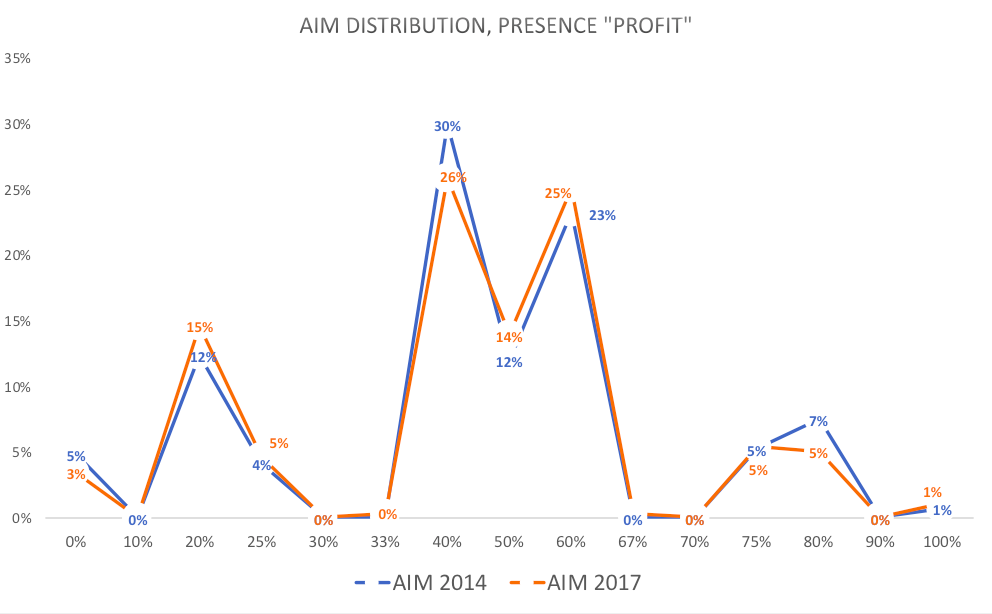
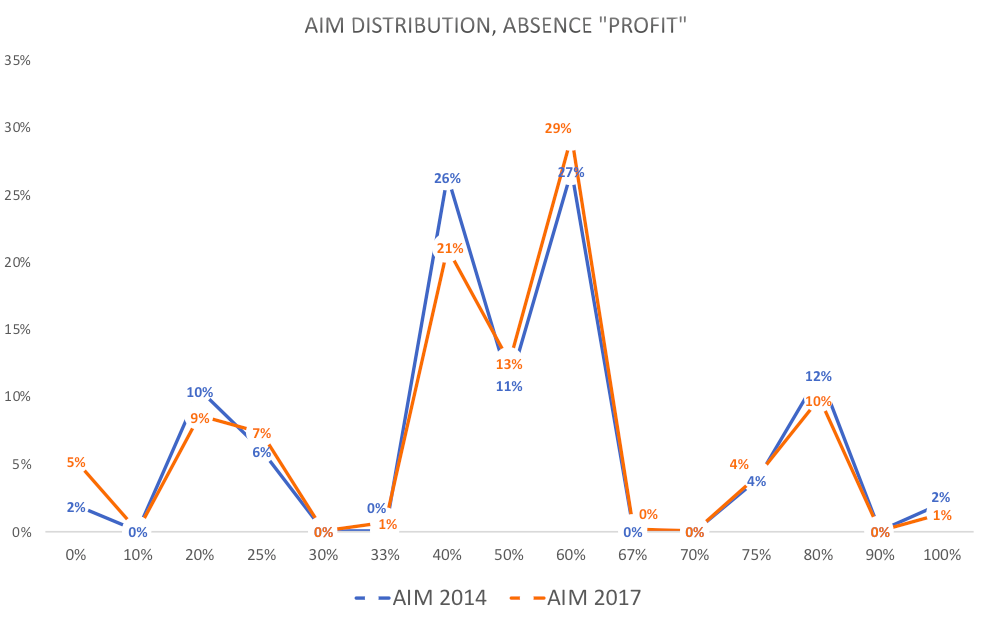
Two other graphs are built following the same logic regarding the presence or absence of the company website and Facebook account.4 In this case, we investigated how the use of technology can modify the AIM index. The results are very interesting. Both in 2014 and 2017, projects that finally opened online communication channels are less aligned than projects without them: the averages of the AIM index are 45.3 percent vs. 50.9 percent in 2014, and 46.9 percent vs. 49 percent in 2017, for the two groups.
At the same time, however, projects with online communications increase their alignment over time, while projects without them move in the opposite direction. As a result, the gap between the AIM averages reduces significantly as time goes by: the gap between the two groups of projects is 2.1 percent in 2017 while it was 5.6 percent in 2014.
Two different indications can be drawn from these observations: projects’ online communication channels and fellows’ technology proficiency in general do not seem to be associated with the capability of focusing on the most urgent needs and necessities of the country. This may be due to the fact that a closer link to a specific local context may make less relevant the presence of a website or of a Facebook profile, as arm-length relations constitute the backbone of the project. This is of course a speculative explanation. However, as speculative as it may be, it certainly calls for a deeper investigation of the relationship between Ashoka fellows’ actions and technology, also in the face of the Digital Revolution that is gaining more momentum every day.
Indeed, we observe some movements along this line: the second observation spurring from our data is that the convergence between using technology and addressing the most urgent issues of a country is increasing. The use of online channels helps changemakers to detect in advance the most important issues of their context, and align their projects to them, while being excluded from the digital world can in fact create lock-ins to the current context, thereby reducing future alignment.
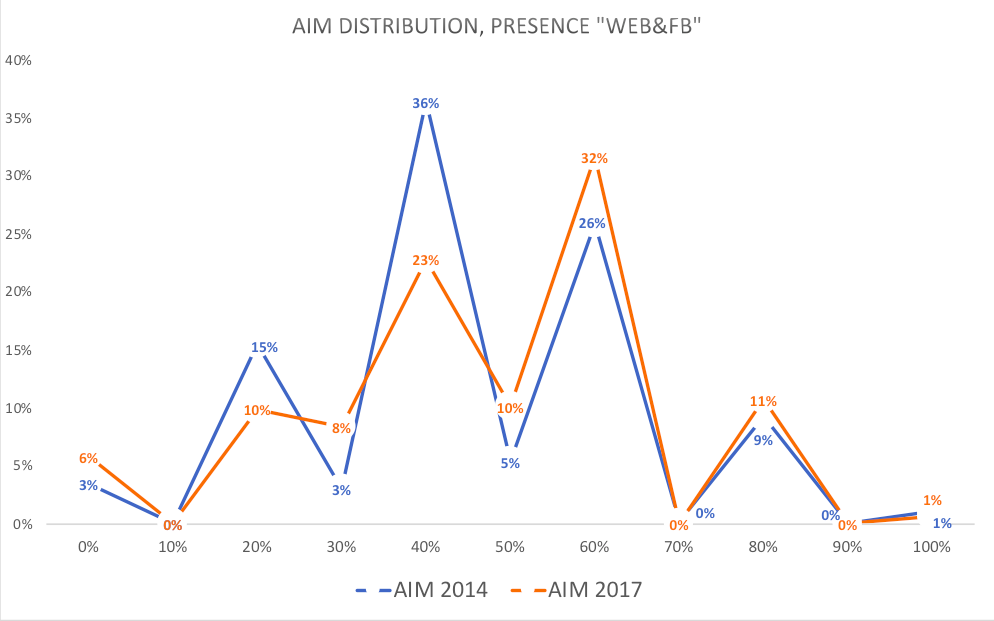
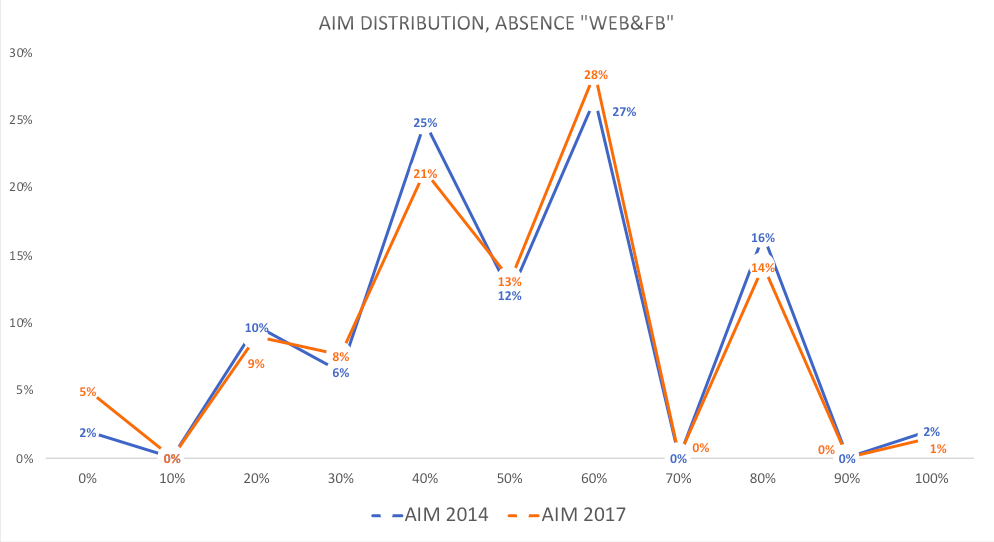
The analysis we have conducted was meant to detect the level of alignment between the missions Ashoka fellows adopted as a compass of their actions and the most urgent issues faced by the country they operate in. We have first seen that the large majority of projects launched by Ashoka fellows aligns between 40 percent and 60 percent, and over time their missions increase their alignment: even if the average alignment remains similar between 2014 and 2017, the peak in 60 percent increases while the frequency in 40 percent decreases. Overall, our study shows the crucial role Ashoka has in selecting projects and fellows that can really make a change tackling and even anticipating the most important issues faced by their countries. At the same time, it also highlights the potential for further development, showing that alignment can be importantly increased even more, trying to push the bulk of projects towards the threshold of 60 percent of the AIM index.
We also noticed that there are opposite forces acting on the level of fellows’ alignment to their country’s most urgent issues: the anchorage to a specific community of reference, which acts positively, and including profits as another aim of the mission, which instead has a negative effect. On the one hand, a fellow’s link to a community, which most likely would be the project beneficiaries’ community, assures a source of information, contacts, sensible relations, that are likely to direct the fellow to grasp what is really relevant in his or her context of action. On the other hand, the need to compromise with profit-related concerns may impose a limit to the change the fellow can imagine pursuing, either pushing toward a narrower focus, or simply directing his or her activity towards issues that are not pressing for his or her context, but only useful to make the project economically viable. Both these observations clearly point towards specific policies Ashoka could undertake. On the one hand, favoring and nurturing fellows’ connection with their local communities. On the other hand, helping changemakers to develop ideas and sensitivities embracing hybrid organizational models, that can reach impact and generate economic sustainability at the same time.
A final note relates to the role of technology. Interestingly, the most technology proficient fellows do not seem to align at the same level as those that are not. There seems to be a trade-off between the use of technology in communication and the capability to detect the most urgent issues, maybe because this last ability is rooted in the closeness to local communities and use of arm-length ties that do not need --and are likely not used to -- online interaction. However, in the face of the Digital Revolution, this trade-off must be overcome, or changemakers seriously risk being left at the margin of the new emerging economic and social systems. Indeed, we observe that over time the divergence between alignment and technology proficiency decreases, as online projects acquire more alignment while projects outside the digital world lose grip. This natural trend can represent a crucial indication for Ashoka, which may improve its support of the digitalization of the projects fellows engage in, in this way intercepting one of the largest changes our society is facing and making it an asset rather than an obstacle.
Footnotes
1 In this case we used the Human Development Index, which expresses the level of personal growth the citizens of the country can achieve along several dimensions. In this work we do not focus on those many dimensions, but rather relate the actual values of the HDI to the possibility for citizens to acquire autonomously the economic means needed for their projects. In other words, we read a high value of the HDI as expressing citizens’ high potential to create economically viable projects, irrespectively of their nature.
2 As missions can evolve over time, we computed the distribution of AIM for a certain year using the mission statements relative to that year.
3 Again, we computed AIM for a certain year using the mission statement of the same year.
4 In this case, the information relative to the website and the Facebook profile are available only for the year 2017. However, we aim only at capturing the fellows’ technology proficiency, which is likely not to change much over three years.


